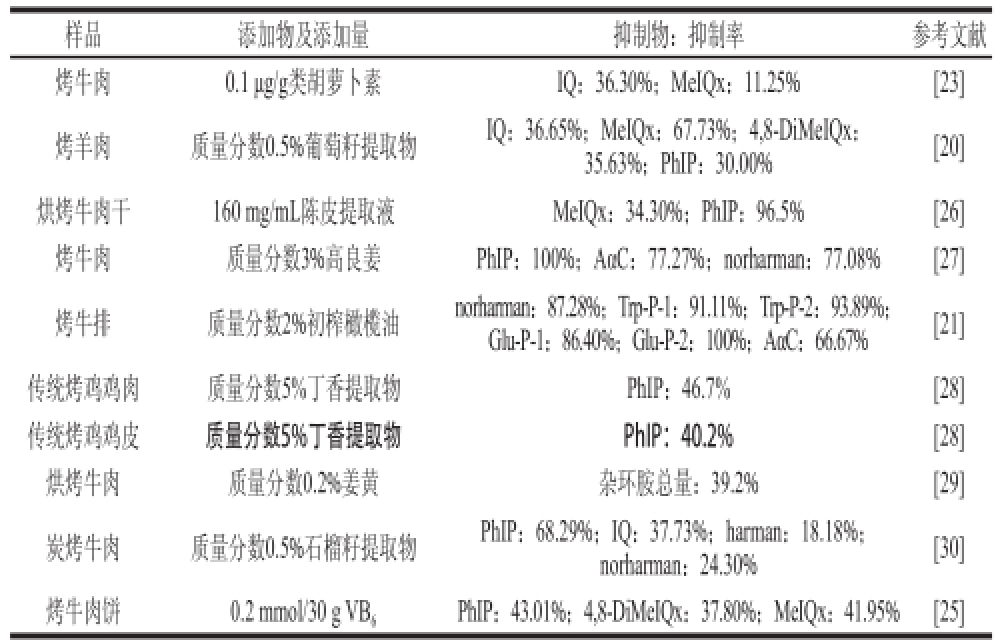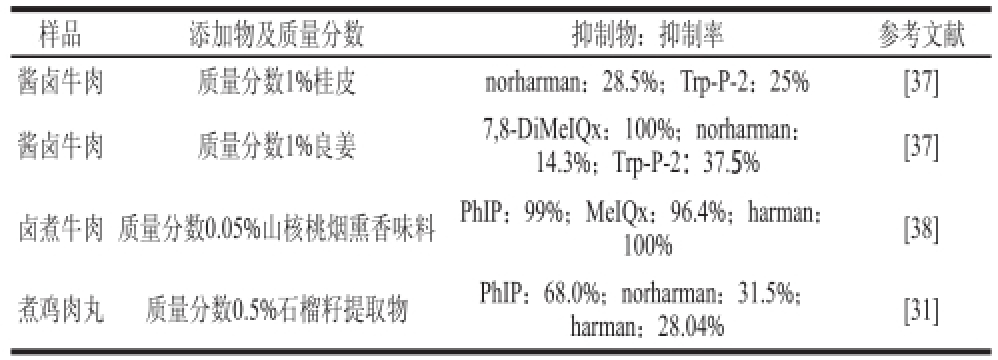外源成分对肉制品中杂环胺抑制效果的研究进展
陈 炎,蔡克周*,杨 潇,刘亚茜,潘丽军,姜绍通,陈从贵
(合肥工业大学生物与食品工程学院,安徽省农产品精深加工重点实验室,安徽 合肥 230009)
摘 要:杂环胺是一类由高蛋白类食品在高温烹调加工时产生的具有致癌和致突变性的有机物。肉制品加工过程中烧烤、卤煮、煎炸和油炸等多种热加工方式均可导致杂环胺的生成,通过添加外源成分抑制肉制品加工过程中杂环胺的形成是当前研究热点。本文重点对外源添加成分对不同加工方式肉制品杂环胺形成的抑制研究进行综述,并对其研究现状进行简要总结。
关键词:外源成分;杂环胺;肉制品;抑制
肉制品是人们日常饮食的重要组成部分,能提供丰富的蛋白质、维生素及镁、锌、铁等微量元素,但是肉类制品在加工过程中常会伴随着有害物质的产生,杂环胺就是其中的一种,主要产生于烧烤、卤煮、煎炸等肉制品加工过程中,已经引起人们的普遍关注。
杂环胺是一类由碳、氮、氢原子组成的具有多环芳香族结构的化合物,是高蛋白类食品在高温烹调加工时产生的具有致癌和致突变性的有机物。自从1977年日本科学家Sugimura等
[1]在烤鱼中发现杂环胺以来,至今在人们所食用的肉制品中已发现30多种杂环胺。根据化学结构特征杂环胺可分为两大类:氨基咪唑氮芳香烃(aminoimidazo azaarens,AIAs)和氨基咔啉
[2]。AIAs包括喹啉类(2-氨基-3-甲基咪唑并[4,5-f]喹啉(2-amino-3-methylimidazo[4,5-f]quinoine,IQ)、2-氨基-3,4-二甲基咪唑并[4,5-f]喹啉(2-amino-3,4-dimethylimidazo[4,5-f]quinoine,MeIQ)、喹喔类(2-氨基-3-甲基咪唑并[4,5-f]喹喔啉(2-amino-3-methylimidazo[4,5-f]quinoxaline,IQx)、2-氨基-3,8-二甲基咪唑并[4,5-f]喹喔啉(2-amino-3,8-dimethylimidazo[4,5-f]quinoxaline,MeIQx)、2-氨基-3,4,8-三甲基咪唑并[4,5-f]喹喔啉(2-amino-3,4,8-trimethylimidazo[4,5-f]quinoxaline,4,8-DiMeIQx)、2-氨基-3,7,8-三甲基咪唑并[4,5-f]喹喔啉(2-amino-3,7,8-trimethylimidazo[4,5-f]quinoxaline,7,8-DiMeIQx)、2-氨基-3,4,7,8-四甲基咪唑并[4,5-f]喹喔啉(2-amino-3,4,7,8-tetramethyl-3H-imidazo[4,5-f]quinoxaline,4,7,8-TriMeIQx))、吡啶类(2-氨基-1-甲基-6-苯基咪唑并[4,5-b]吡啶(2-amino-1- methyl-6-phenylimidazo[4,5-b]pyridine,PhIP))以及呋喃吡啶类(2-氨基-1,6-二甲基呋喃并[4,5-b]吡啶(2-amino-(1,6-dimethylfuro[3,2-e]-imidazo[4,5-b])pyridine,IFP))。此类HAAs一般在烹调温度150~300 ℃下由肌酸/肌酐酸、氨基酸和还原糖发生Millard反应生成
[3];氨基咔啉包括α-咔啉(2-氨基-9H-吡啶并[2,3-b]吲哚(2-amino-9H-pyrido[2,3-b]indole,AαC)、2-氨基-3-甲基-9H-吡啶并[2,3-b]吲哚(2-amino-3-methyl-9H-pyrido[2,3-b]indole,MeAαC))、β-咔啉(1-甲基-9H-吡啶并[3,4-b]吲哚(1-methyl-9H-pyrido[3,4-b]indole,harman)、9H-吡啶并[3,4-b]吲哚(9H-pyrido[3,4-b]indole,norharman))、γ-咔啉(3-氨基-1,4-二甲基-5H-吡啶并[4,3-b]吲哚(3-amino-1,4-dimethyl-5H-pyrido [4,3-b]indole,Trp-P-1)、3-氨基-1-甲基-5H-吡啶并[4,3-b]吲哚(3-amino-1-methyl-5H-pyrido[4,3-b]indole,Trp-P-2)和δ-咔啉(2-氨基-6-甲基二吡啶并[1,2-a:3',2'-d]咪唑(2-amino-6-methyldipyrido[1,2-a:3',2'-d] imidazole,Glu-P-1)、2-氨基-二吡啶并[1,2-a:3',2'-d]咪唑(2-amino-dipyrido[1,2-a:3',2'-d]imidazole, Glu-P-2)),此类杂环胺主要是氨基酸和蛋白质在温度高于300 ℃时热裂解而产生
[4]。
近30 a来,国外对杂环胺的毒性评价、分离检测、形成机制和控制方法等方面进行了深入研究
[5],而我国对杂环胺的研究起步较晚,随着人们食品安全意识的逐步加强,加工肉制品中有害物的预防和控制已经成为行业研究热点。本文将重点介绍添加外源成分对不同加工方式肉制品中杂环胺产生的抑制作用,为肉制品的安全加工提供切实可行的参考依据。
1 杂环胺的形成机制和抑制机理
1.1 杂环胺的形成机制
Millard反应除了能增加食品的风味外,在杂环胺的形成过程中也有着重要作用。IQ是现有报道中生物毒性最强的杂环胺
[3],Jageerstad等
[6]研究表明存在于肉类中的肌酸、氨基酸和己糖可能是IQ型杂环胺的前体物,并推测了其形成途径。这个途径随后被Negishi等
[7]通过肌酸、甘氨酸和葡萄糖混合体系模型证实,他们将模型体系在130 ℃条件下沸腾回流2 h后,即检测到体系中IQ的杂环胺的形成。对于MeIQx和7,8-DiMeIQx,Milic等
[8]认为Maillard反应和Strecker反应的动力学是MeIQx和7,8-DiMeIQx形成的第一步,即形成了吡啶和吡嗪自由基,第二步吡啶和吡嗪自由基与肌酐酸反应最终得到吡啶和吡嗪的衍生物MeIQx和7,8-DiMeIQx。PhIP的形成机理目前研究较为深入,Zochling等
[9]在前人的基础上,发现PhIP形成有三步反应:1)苯丙氨酸热裂解生成苯乙醛;2)苯乙醛和肌酸发生醇醛脱水缩合反应;3)缩合产物和氨基酸的氨基杂化,最终形成PhIP。氨基咔啉类杂环胺中关于harman和norharman的形成机制已经有较为明确的理论
[10],氨基酸或氨基酸的混合物、肌酸和葡萄糖等前体物,通过Pictet-Spengler反应形成亚胺离子的中间体(Schiff碱)在酸催化下环化得到四氢化-β-咔啉(tetrahydronaphthalene-β-carboline,THβC),THβC的吲哚又经环氧化形成harman和norharman,但这种反应取决于加热时间、水分含量、温度和pH值以及所涉及到的多种前体物。
1.2 杂环胺形成的抑制机理
现有对食品加工过程中杂环胺的形成抑制报道,以添加外源活性成分研究最多,对外源成分抑制杂环胺形成的具体机理目前仍然知之甚少,现有研究主要的观点有两种,其一是通过外源成分的抗氧化性清除自由基能力实现杂环胺的抑制。Vitaglione等
[11]认为食品加工过程产生的多种氧化自由基参与多种杂环胺的生成,因而可以通过清除自由基方式来抑制杂环胺的形成。Balogh等
[12]认为VE通过清除自由基对烹饪牛肉中PhIP形成抑制。Viegas等
[13]研究发现在牛肉馅饼中添加香料提取物可以抑制杂环胺的形成,并且香料提取物的自由基清除能力与对杂环胺的抑制效果成正相关。另外一种观点认为外源活性成分与杂环胺前体化合物形成稳定加合物而抑制杂环胺的生成。Cheng等
[14-16]通过在炒牛肉中添加苹果提取物来抑制极性杂环胺的形成,这一抑制效果与提取物总酚含量或者自由基清除能力均没有明显的对应关系,进一步分析表明,原花青素、根皮苷和绿原酸作为反应物参与抑制杂环胺形成的反应中,由此认为活性物质有可能是通过结合活性羰基来抑制PhIP的形成,即苯丙氨酸经过Maillard反应形成苯乙醛,柚皮素和儿茶素没食子酸酯等酚类物质能通过和苯乙醛上羰基形成两种稳定的加合物,从而阻断苯乙醛与肌酐的反应,抑制PhIP的形成。此外,外源成分对极性和非极性杂环胺形成的抑制机理是不是有差别,目前尚不清楚。
2 外源成分对不同加工方式肉制品中杂环胺形成的抑制
烧烤(炭烤、电烤等)、卤煮、油煎和油炸是目前肉制品的主要加工方法,这几类加工肉制品中均被检测到有杂环胺的生成,国内外在添加外源活性成分抑制杂环胺的形成方面已经有广泛研究,表明天然或人工抗氧化剂和一些植物提取物等具有明显的抑制效果。但是不同加工方式对肉制品中杂环胺的生成的种类、含量等会有不同的影响,不同的外源成分对杂环胺的抑制效果也有所不同,因此有必要区分外源成分对不同加工肉制品中杂环胺的抑制效果。
2.1 外源成分对烧烤肉制品中杂环胺形成的抑制
烧烤肉制品是指通过高温加热(炭烤、电烤等),将肉类置于靠近热源的位置加热熟化而得到的肉制品。由于烧烤过程中肉制品表面温度最高可超过200 ℃,时间超过2 min就会产生大量的杂环胺
[17]。Liao Guozhou等
[18]研究发现炭烤鸡胸肉和鸭胸肉杂环胺含量分别达到112、32 ng/g,而电烤箱烤鸡胸肉和鸭胸肉杂环胺含量分别为4、7 ng/g,明显少于炭烤。在鸡胸肉炭烤20 min后检测到9 种杂环胺,含量较多的是norharman(32.2 ng/g)、harman(32 ng/g)、PhIP(31.1 ng/g);而鸭胸肉则检测到10 种杂环胺,含量较多的是PhIP(12 ng/g)、harman(8 ng/g)、norharman(5 ng/g)。Hilal等
[19]报道了在自然对流情况下电烤箱烤鸡肉饼,发现PhIP、norharman、harman的最高含量可以达到616.15、447.15、504.25 μg/kg。
现有报道可以抑制烧烤肉制品中杂环胺的形成的外源成分主要是天然抗氧化物,如香辛料
[14,18]、植物提取物等
[14,20-22]。Vitaglione等
[23]报道西红柿能够显著抑制牛肉中IQ型杂环胺的产生,并推测这可能与西红柿中含有抗氧化活性成分表胡萝卜素有关。在类胡萝卜素0.1 μg/g的浓度水平下,可使肉制品中IQ和MelQx的含量分别减少36%和11%。廖国周
[20]发现将葡萄籽提取物、槲皮素和VE涂在羊肉表面后再烘烤,可以有效抑制IQ型杂环胺的产生。研究发现在烤鸡和烤牛排中加入橄榄油可以抑制IQ、norharmam和harman的生成
[21-22]。迷迭香、槲皮素、表儿茶素、茶黄素可以降低烤牛肉馅饼中PhIP、MeIQx和4,8-MeIQx的产生
[17]。Khalifah等
[24]发现牛肉饼在烘烤前添加VB
6可以明显抑制多种杂环胺的形成,并发现这可能与其抑制Maillard反应有关。Wong等
[25]比较了VC、烟酸和VB
6对烤牛肉饼中3 种杂环含量的影响,发现可以抑制杂环胺的生成,其中VB
6的效果最佳。表1是不同外源添加 成分对烧烤肉制品中杂环胺的抑制效果。
表1 不同外源添加成分对烧烤肉制品中杂环胺的抑制效果
Table 1 Inhibitory effect of exogenous additives on heterocyclic amines in grilled meat

样品 添加物及添加量 抑制物:抑制率 参考文献烤牛肉 0.1 μg/g类胡萝卜素 IQ:36.30%;MeIQx:11.25% [23]烤羊肉 质量分数0.5%葡萄籽提取物 IQ:36.65%;MeIQx:67.73%;4,8-DiMeIQx:35.63%;PhIP:30.00% [20]烘烤牛肉干 160 mg/mL陈皮提取液 MeIQx:34.30%;PhIP:96.5% [26]烤牛肉 质量分数3%高良姜 PhIP:100%;AαC:77.27%;norharman:77.08% [27]烤牛排 质量分数2%初榨橄榄油 norharman:87.28%;Trp-P-1:91.11%;Trp-P-2:93.89%;Glu-P-1:86.40%;Glu-P-2:100%;AαC:66.67% [21]传统烤鸡鸡肉 质量分数5%丁香提取物 PhIP:46.7% [28]传统烤鸡鸡皮 质量分数5%丁香提取物 PhIP:40.2% [28]烘烤牛 肉 质量分数0.2%姜黄 杂环胺总量:39.2% [29]炭烤牛肉 质量分数0.5%石榴籽提取物 PhIP:68.29%;IQ:37.73%;harman:18.18%;norharman:24.30% [30]烤牛肉饼 0.2 mmol/30 g VB
6 PhIP:43.01%;4,8-DiMeIQx:37.80%;MeIQx:41.95% [25]
2.2 外源成分对卤制肉制品中杂环胺的抑制
卤制肉制品是以禽畜肉或内脏等其他副产物为原料,加入调味料或卤水煮制而得到,是一种传统的肉制品加工方法,其加工温度基本不超过110 ℃,但是热处理时间长,主要有酱卤、卤煮等方式。Guo Haitao等
[31]测定了羊肉卤煮1 h和2 h后的杂环胺含量,分别为51.07、95.33 ng/g,其中以氨基咔啉类杂环胺为主。潘晗
[32]检测了酱羊肉中的杂环胺,以norharmam和harman比例最高。廖国周等
[33]测定了卤牛肉中杂环胺的含量,发现norharmam和harman的含量分别达到了29.16、33.90 ng/g,而其他杂环胺则未被检测出。杨洪生等
[34]测定了水煮草鱼杂环胺的含量,也仅检测到norharmam和harman生成。但也有报道在猪肉中加入10%的酱油和10%的冰糖卤煮4 h后,可检测到IQ、MeIQx、MeIQ、4,8-DiMeIQx、Trp-P-1、PhIP和AαC,其中MeIQx含量最高,为3.43 ng/g,这可能与其添加了大量酱油有关
[35]。
姚瑶等
[36]研究表明丁香、桂皮、良姜、红花椒和香叶可以降低酱肉中β-咔啉、γ-咔啉和IQ型杂环胺等的含量,其中对norharmam的抑制更显著。杨潇等
[37]发现山楂核烟熏香味料可以显著抑制卤煮牛肉中MeIQx、PhIP、harman的生成。表2是不同外源添加成分对卤制肉制品中杂环胺的抑制效果。
表2 不同外源添加成分对卤制肉制品中杂环胺的抑制效果
Table 2 Inhibitory effect of exogenous additives on heterocyclic amines in stewed meat

样品 添加物及质量分数 抑制物:抑制率 参考文献酱卤牛肉 质量分数1%桂皮 norharman:28.5%;Trp-P-2:25% [37]酱卤牛肉 质量分数1%良姜 7,8-DiMe IQx:100%;norharman:14.3%;Trp-P-2:37.5% [37]卤煮牛肉 质量分数0.05%山核桃烟熏香味料 PhIP:99%;MeIQx:96.4%;harman:100% [38]煮鸡肉丸 质量分数0.5%石榴籽提取物 PhIP:68.0%;norharman:31.5%;harman:28.04% [31]
2.3 外源成分对煎炸、油炸肉制品中杂环胺的抑制
煎炸和油炸就是以油脂作为传热介质使食物从表面向内热脱水而使食物成熟的过程。由于温度可以达到200 ℃以上,这类肉制品加工容易产生大量的杂环胺。Frandsen
[38]通过小鼠实验证实了煎炸肉制品的致癌性,是由于其中含有PhIP和4,8-DiMeIQx。Wang Yuan等
[39]研究发现在草鱼煎炸时有7,8-DiMeIQx、norharmam、harman和PhIP生成,并随着煎炸时间的增加有上升趋势。Liao Guozhou等
[18]研究发现油煎鸭胸肉杂环胺含量达到53.3 ng/g,约是油煎鸡胸肉(27.4 ng/g)的2倍。Sinha等
[28]报道称在油煎去皮且无骨的鸡胸肉中PhIP的含量达到了70 ng/g。Brockstedt等
[40]检测了油煎火鸡鸡胸肉中的PhIP含量达到了64.9 ng/g。
Monika等
[41]发现在牛肉饼油炸前用木槿提取物腌泡可以使杂环胺的总量保持在较低的浓度,并使MeIQx的含量大幅下降。Hala
[42]研究发现对于烧鸡中杂环胺的形成,加入绿茶和橄榄油混合物具有更强的抑制作用。对于煎牛肉中的杂环胺,VE溶液也具有良好的抑制效果
[13]。Wang Yi等
[43]认为大豆浓缩蛋白也具有减少油炸牛肉中杂环胺的作用。表3是不同外源添加成分对煎炸、油炸肉制品中杂环胺的抑制效果。
表3 不同外源添加成分对煎炸、油炸肉制品中杂环胺的抑制效果
T
Taabbllee 33 IInnhhiibbiittoorryy eefffect of exogenous additives on heterocyclic amines in fried and deep-fried meat

样品 添加物及质量分数 抑制物:抑制率 参考文献油炸牛肉饼 质量分数0.8%木槿提取物 MeIQx:50% [41]油炸牛肉饼 质量分数0.1%葡萄籽提取物 MeIQx:36.8%;PhIP:50% [44]油煎牛肉丸 质量分数0.5%石榴籽提取物 PhIP:26.1%;IQ:44.7% [30]油煎鸡肉丸 质量分数0.5%石榴籽提取物 Norharman:52.2%;IQ:45.92%;MeIQx:49.39% [30]烧鸡 质量分数2%绿茶+橄榄油 PhIP:100%;Trp-P-1:100% [42]炸牛肉馅饼 质量分数0.2%葡萄籽提取物 MeIQx:50%;PhIP:33.33% [45]炸牛肉馅饼 质量分数1.2%迷迭香萃取物 MeIQx:57.14%;PhIP:99.9% [45]煎牛肉 质量分数1.25%绿茶 MeIQx:9.75%;PhIP:50%;AαC:61.9% [46]
2.4 外源成分对其他加工方式肉制品和模型体系中杂环胺的抑制
除了上述方式加工的肉制品外,采用其他方式加工肉质品也会生成杂环胺。Liao Guozhou等
[47]检测发现肉松中杂环胺的种类多达7 种,并对其控制方法进行研究发现0.1%的VE可以减少norharman、PhIP、AαC和MeAαC的含量。Ahn等
[48]研究表明使用香料腌制牛肉可以有效减少炒牛肉中杂环胺的含量。Melo等
[49]研究发现用红酒和啤酒腌制鸡胸肉可以明显抑制MeIQx和PhIP的生成,但红酒腌制则促进了harman的生成。
此外在模型体系中研究外源成分对杂环胺的抑制作用也是一种很好的方法。Cheng等
[50]在模拟杂环胺形成的模型体系中发现,表儿茶素、槲皮素等可以抑制PhIP、MeIQx和4,8-DiMeIQx的产生。Johansson等
[51]研究发现在模型体系中1 000 mg/kg VC可以减少84% MeIQx的形成。Lee等
[52]研究发现黄酮可以抑制MeIQx和7,8-DiMeIQx的形成,抑制效果可以达30%。Oguri等
[53]在肌酸、葡萄糖与甘氨酸的模型系统中加入抗氧化剂,发现丁香酸、阿魏酸和槲皮素对MeIQx的抑制率可以达到50%以上。
3 结 语
综上所述,烧烤、卤制、煎炸和油炸等多种加工方式均可导致杂环胺的形成,多种外源成分具有抑制肉制品加工过程杂环胺形成的特性。烧烤肉制品中添加陈皮提取物、葡萄籽提取物、石榴籽提取物、高良姜、橄榄油和VB
6等成分,主要可以抑制IQ、MeIQx、PhIP、AαC等杂环胺的形成;卤制肉制品中添加桂皮、良姜、山核桃烟熏液和石榴籽提取物等主要可以抑制norharman、harman、Trp-P-2、PhIP等杂环胺的形成;煎炸和油炸肉制品中添加木槿提取物、葡萄籽提取物、石榴籽提取物、绿茶提取物等主要可以抑制IQ、MeIQx、PhIP的形成。
研究报道的外源添加物都可以显著降低杂环胺的总量,但各自对不同种类杂环胺的影响程度还有较大差异,因此有必要将这些外源添加物配合使用,研究抗氧物合适的配比,通过它们之间协同作用使其抑制效果更加良好,对指导肉制品的安全加工生产,减少有害物质对人类健康的危害具有重要意义。另一方面,外源成分主要是水果、蔬菜和香辛料的提取物,以及人工合成的化合物,来源形式差异大,需要进一步深入研究其核心功能性成分及抑制的化学机制,以便于挖掘更多具有相同成分或者功能的食品添加剂。
参考文献:
[1] SUGIMURA T, NAGAO M, KAWACHI T, et al. Mutagens carcinogens in food, with special reference to highly mutagenic pyrolytic products in broiled food[M]. New York: Cold Spring Harbor Laboratory Press, 1977: 1561-1577.
[2] JAGERSTAD M, SKOG K, ARVIDSSON P, et al. Chemistry formation and occurrence of genotoxic heterocyclic amines identifi ed in model systems and cooked foods[J]. European Food Research and Technology, 1998, 207(6): 419- 427.
[3] ALAEJOS M S, GONZALEZ V, AFONSO A M, et al. Exposure to heterocyclic aromatic amines from the consumption of cooked red meat and its effect on human cancer risk: a review[J]. Food Additives and Contaminants. Part A, Chemistry, Analysis, Control, Exposure & Risk Assessment, 2008, 25(1): 2-24.
[4] TORIBIO F, MOYANO E, PUIGNOU L, et al. Ion-trap tandem mass spectrometry for the determination of heterocyclic amines in food[J]. Journal of Chromatography A, 2002, 948(1/2): 267-281.
[5] TURSKEY R J. Formation and biochemistry of carcinogenic heterocyclic aromatic amines in cooked meats[J]. Toxicology Letters,2007, 168 (3): 219-227.
[6] JAGEERSTAD M, LASER R A, OSTE R, et al. Creatinine and Maillard reaction products as precursors of mutagenic compounds formed in fried beef[J]. Acs Symposium Series, 1983, 215(1): 507-519.
[7] NEGISHI C, WAKABAYASHI K, TSUDA M, et al. Formation of 2-amino-3,7,8-trithylimidazo[4,5-f]quinoxaline a new mutagen by heating a mixture of creatinine glucose and glycine[J]. Mutation Research Letters, 1984, 140(2): 55-59.
[8] MILIC B L, DJILAS S M, CANADANOVIC-BRUNET J M. Synthesis of some heterocyclic amino-imidazozarones[J]. Food Chemistry, 1993, 46(10): 273-276
[9] ZOCHLING S, MURKOVIC M. Formation of the heterocyclic aromatic amine PhIP identifi cation of precursors and intermediates[J]. Food Chemistry, 2002, 79(1): 125-134.
[10] HERRAIZ T. Tetrahydro-beta-carbolines, potential neuroactive alkaloids, in chocolate and cocoa[J]. Journal of Agricultural and Food Chemistry, 2000, 48(10): 4900-4904.
[11] VITAGLIONE P, FOGLIANO V. Use of antioxidants to minimize the human health risk associated to mutagenic/carcinogenic heterocyclic amines in food[J]. Journal of Chromatography B, 2004, 802(1): 189-199.
[12] BALOGH Z, GRAY J I, GOMAA E A, et al. Formation and inhibition of heterocyclic aromatic amines in fried ground beef patties[J]. Food and Chemical Toxicology, 2000, 38(5): 395- 401.
[13] VIEGAS O, AMARO L F, FERREIRA I M, et al. Inhibitory effect of antioxidant-rich marinades on the formation of heterocyclic aromatic amines in pan-fried beef[J]. Journal of Agricultural and Food Chemistry, 2012, 60(24): 6235-6240.
[14] CHENG K W, WONG C C, CHAO J, et al. Inhibition of mutagenic PhIP formation by epigallocatechin gallate via scavenging of phenylacetaldehyde[J]. Molecular Nutrition & Food Research, 2009,53(6): 716-725.
[15] CHENG K W, WONG C C, CHO C K, et al. Trapping of phenylacetaldehyde as a key mechanism responsible for naringenin's inhibitory activity in mutagenic 2-amino-1-methyl-6-phenylimidazo[4,5-Z]pyridine formation[J]. Chemical Research in Toxicology, 2008, 21(10): 2026-2034.
[16] CHENG K W, WU Qingli, ZHENG Zongping, et al. Inhibitory effect of fruit extracts on the formation of heterocyclic amines[J]. Journal of Agricultural and Food Chemistry, 2007, 55(25): 10359-10365.
[17] 冯云, 彭增起, 崔国梅. 烘烤对肉制品中多环芳烃和杂环胺含量的影响[J]. 肉类工业, 2009, 8(1): 27-30.
[18] LIAO Guozhou, WANG Guiying, XU Xinglian, et al. Effect of cooking methods on the formation of heterocyclic aromatic amines in chicken and duck breast[J]. Meat Science, 2010, 85(1): 149-154.
[19] HILAL I, TANSEL K, .ZG.L ., et al. Effect of oven cooking method on formation of heterocyclic amines and quality characteristics of chicken patties: steam-assisted hybrid oven versus convection ovens[J]. Poultry Science, 2014, 93(9): 2296-2303.
[20] 廖国周. 烧烤肉制品中杂环胺形成规律研究[D]. 南京: 南京农业大学, 2008: 9-19.
[21] LEE J, DONG A, JUNG K, et al. Influence of extra virgin olive oil on the formation of heterocyclic amines in roasted beef steak[J]. Food Science and Biotechnology, 2011, 20(1): 159-165.
[22] MONTI S M, AMBROSINO P, SKOG K, et al. Characterization of phenolic compounds in virgin olive oil and their effect on the formation of carcinogenic/mutagenic heterocyclic amines in a model system[J]. Journal of Agricultural and Food Chemistry, 2001, 49(8):3969-3975.
[23] VITAGLIONE P, MONTI S M, AMBROSINO P, et al. Carotenoids from tomatoes inhibit heterocyclic amine formation[J]. European Food Research and Technology, 2002, 215(2): 108-113.
[24] KHALIFAH R G, BAYNES J W, HUDSON B G. Amadorins:novel post-amadori inhibitors of advanced glycation reactions[J]. Biochemical and Biophysical Research Communications, 1999,257(2): 251-258.
[25] WONG D, CHENG K W, WANG Mingfu. Inhibition of heterocyclic amine formation by water-soluble vitamins in Maillard reaction model systems and beef patties[J]. Food Chemistry, 2012, 133(3): 760-766.
[26] 夏新武, 王武, 陈从贵, 等. 陈皮对烘烤牛肉干中杂环胺含量的影响[J].肉类研究, 2013, 27(11): 19-23.
[27] 吕美. 香辛料的抗氧化性及其对煎烤牛肉饼中杂环胺形成的影响[D].无锡: 江南大学, 2011: 22-35.
[28] SINHA R, ROTHMAN N, BROWN E D, et al. High concentrations of the carcinogen 2-amino-1-methyl-6-phenylimidazo-[4,5-b]pyridine(PhIP) occur in chicken but are dependent on the cooking method[J]. Cancer Research, 1995, 55(20): 4516-4519.
[29] PUANGSOMBAT K, JIRAPAKKUL W, SMITH J S, et al. Inhibitory activity of Asian spices on heterocyclic amines formation in cooked beef patties[J]. Journal of Food Science, 2011, 76(8): 174-180.
[30] KEŞKEKOĞLU H, .REN A. Inhibitory effects of pomegranate seed extract on the formation of heterocyclic aromatic amines in beef and chicken meat balls after cooking by four different methods[J]. Meat Science, 2014, 96(4): 1446-1451.
[31] GUO Haitao, WANG Zhenyu, PAN Han, et al. Effects of traditional Chinese cooking methods on formation of heterocyclic aromatic amines in lamb patties[J]. Food Science and Biotechnolgy, 2014,23(3): 747-753.
[32] 潘晗. 酱肉中norharman和harman形成机理的研究[D]. 北京: 中国农业科学院, 2014: 20-25.
[33] 廖国周, 张英君, 徐幸莲, 等. 传统肉制品中杂环胺的HPLC测定[J].南京农业大学学报, 2008, 31(4): 134-139.
[34] 杨洪生, 徐琦, 张美琴, 等. 不同加工方式下草鱼鱼糜制品中杂环胺生成和变化的研究[J]. 南方水产科学, 2014, 10(3): 73-79.
[35] SUN Li, ZHANG Feng, YONG Wei, et al. Potential sources of carcinogenic heterocyclic amines in Chinese mutton shashlik[J]. Food Chemistry, 2010, 123(3): 647-652.
[36] 姚瑶, 彭增起, 邵斌, 等. 20种市售常见香辛料的抗氧化性对酱牛肉中杂环胺含量的影响[J]. 中国农业科学, 2012, 45(20): 4252-4259.
[37] 杨潇, 蔡克周, 卢进峰, 等. 烟熏液对卤煮牛肉9种杂环胺含量的影响[J]. 食品科学, 2014, 35(21): 68-72. doi: 10.7506/spkx1002-6630-201421014.
[38] FRANDSEN. Excretion of DNA adducts of 2-amino-1-methyl-6-phenylimidazo[4,5-b]pyridine and 2-amino-3,4,8- trimethylimidazo[4,5-f]quinoxaline, PhIP-dG, PhIP-DNA and DiMeIQx-DNA from the rat[J]. Carcinogenesis, 1997, 18(8): 1555-1560.
[39] WANG Yuan, HUI T, ZHANG Yawei, et al. Effects of frying conditions on the formation of heterocyclic amines and trans fatty acids in grass carp[J]. Food Chemistry, 2015, 167(1): 251-257.
[40] BROCKSTEDT U, PFAU W. Formation of 2-amino-carbolines in pan-fried poultry and 32P-postlabelling analysis of DNA adducts[J]. European Food Research and Technology, 1998, 207(6): 472-476.
[41] MONIKA G, JOCHEN W. Inhibitory effect of marinades with hibiscus extract on formation of heterocyclic aromatic amines and sensory quality of fried beef patties[J]. Journal of Food Processing and Preservation, 2010, 85(4): 735-742.
[42] HALA A. The effect of green tea and olive oil on the mutagenic activity of heterocyclic amines extracted from common food consumed in Saudi Arabia[J]. International Journal of Food Sciences and Nutrition, 2011, 62(3): 295-302.
[43] WANG Yi, VUOLO L L, SPINGARN N E, et al. Formation of mutagens in cooked foods V. the mutagen reducing effect of soy protein concentrates and antioxidants during frying of beef[J]. Cancer Letters, 1982, 16(1): 179-189.
[44] DANIELA N, MONIKA G, MARIA TERESA R E, et al. Inhibitory effect of liposomal solutions of grape seed extract on the formation of heterocyclic aromatic amines[J]. Food Chemistry, 2014, 62(1): 279-287.
[45] MONIKA G, JOCHEN W. Antioxidant capacity and inhibitory effect of grape seed and rosemary extract in marinades on the formation of heterocyclic amines in fried beef patties[J]. Food Chemistry, 2012,134(2): 766-774.
[46] QUELHAS I, PETISCA C, VIEGAS O, et al. Effect of green tea marinades on the formation of heterocyclic aromatic amines and sensory quality of pan-fried beef[J]. Food Chemistry, 2010, 122(1):98-104.
[47] LIAO Guozhou, XU Xinglian, ZHOU Guanghong, et al. Effects of cooked temperatures and addition of antioxidants on formation of heterocyclic aromatic amines in poke flos[J]. Journal of Food Processing and Preservation, 2009, 33(1): 159-175.
[48] AHN J, GRUN I U. He t erocyclic amines: inhibitory effects of natural extracts on the formation of polar and non-polar heterocyclic amines in cooked beef[J]. Journal of Food Science, 2006, 70(2): 263-268.
[49] MELO A, VIEGAS O, PETISCA C, et al. Effec t of beer/red wine marinades on the formation of heterocyclic aromatic amines in panfried beef[J]. Journal of Agricultural and Food Chemistry, 2008,56(22): 10625-10632.
[50] CHENG K W, CHEN Feng, WANG Mingfu. Inhibitory activities of dietary phenolic compounds on heterocyclic amine formation in both chemical model system and beef patties[J]. Molecular Nutrition and Food Research, 2007, 51(8): 969-976.
[51] JOHANSSON M A E, JAGERSTAD M. Influence of pro- and antioxidants on the formation of mutagenic-carcinogenic heterocyclic amines in a model system[J]. Food Chemistey, 1996, 56(1): 69-75.
[52] LEE H, JIAAN C Y, TSAI S J. Flavone inhibits mutagen formation during heating in a glycine creatine/glucose model system[J]. Food Chemistry, 1992, 45(1): 235-238.
[53] OGURI A, SUDA M, TOTSUKA K, et al. Inhibitory effects of antioxidants on formation of heterocyclic amines[J]. Mutation Research, 1998, 402(1): 237-245.
Inhibition of Heterocyclic Aromatic Amines in Meat Products by Exogenous Components: A Review
CHEN Yan, CAI Kezhou*, YANG Xiao, LIU Yaqian, PAN Lijun, JIANG Shaotong, CHEN Conggui
(Key Laboratory for Agricultural Products Processing of Anhui Province, School of Biotechnology and Food Engineering,Hefei University of Technology, Hefei 230009, China)
Abstract:Heterocyclic aromatic amines (HAAs), a class of carcinogenic and mutagenic organic compounds, are formed from high-protein foods cooked at high temperature. Grilling, stewing, frying, deep-frying, and other thermal processing methods can lead to the formation of heterocyclic aromatic amines in meat products. The inhibitory effect of exogenous components on the formation of heterocyclic aromatic amines in meat processing has gained extensi ve attention. In this paper the current status of studies on the inhibition of the formation of heterocyclic aromatic amines in meat products by exogenous components are reviewed.
Key words:exogenous components; heterocyclic aromatic amines; meat products; inhibition
中图分类号:TS251.1
文献标志码:A
文章编号:1002-6630(2015)23-0329-05
doi:10.7506/spkx1002-6630-201523059
收稿日期:2015-02-05
基金项目:科技部农业科技成果转化资金项目(2014GB2C300007)
作者简介:陈炎(1992—),男,硕士研究生,研究方向为肉品加工与质量控制。E-mail:chenyansdzs0@sina.com
*通信作者:蔡克周(1980—),男,副教授,博士,研究方向为肉品加工与质量控制。E-mail:kzcai@hfut.edu.cn


